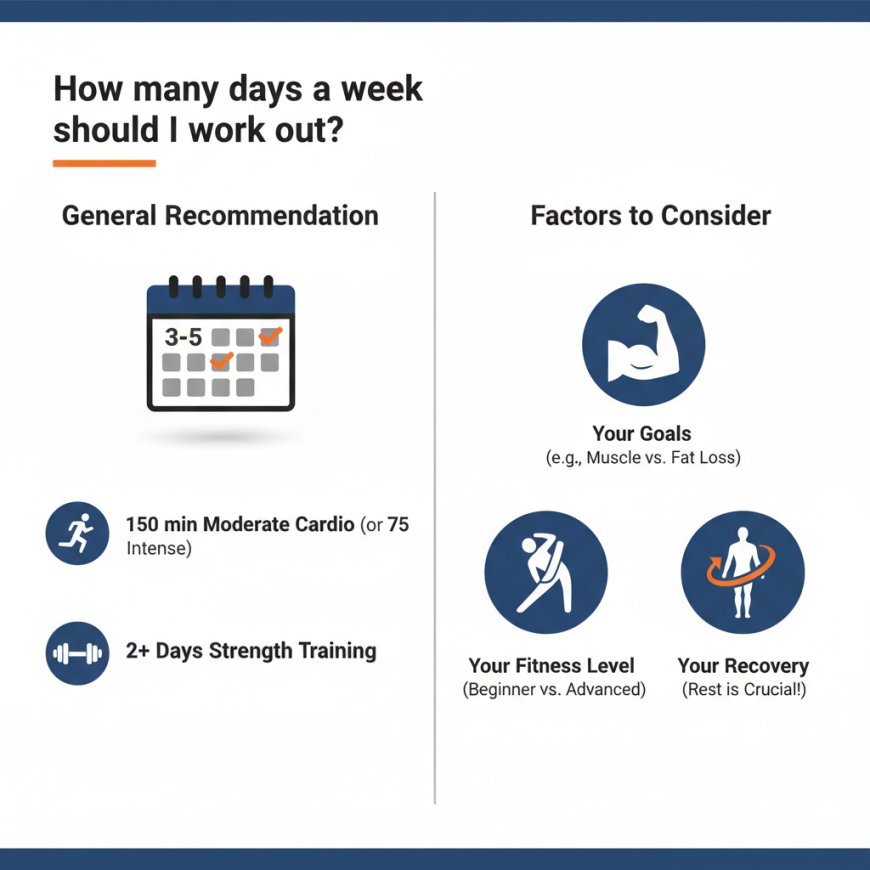How Many Days a Week Should I Work Out?
How Many Days a Week Should I Work Out?

How Many Days a Week Should I Work Out? Finding Your Ideal Fitness Frequency
When you're eager to get fit, lose weight, build muscle, or simply improve your health, one of the first questions that comes to mind is often about frequency. More is better, right? Not always. Understanding the sweet spot between pushing yourself and allowing for recovery is key to sustainable progress.
The General Recommendation: A Solid Starting Point
For most healthy adults, major health organizations like the American Heart Association and the Department of Health and Human Services recommend:
-
150 minutes of moderate-intensity aerobic activity per week OR
-
75 minutes of vigorous-intensity aerobic activity per week
-
2 or more days of muscle-strengthening activity per week
What does this translate to in terms of days?
For a beginner or someone aiming for general health, 3-5 days a week is often ideal.

Factors to Consider When Planning Your Schedule
Let's dive deeper into the variables that will shape your personal workout calendar:
1. Your Fitness Goals
-
Weight Loss: To lose weight, you generally need to be in a calorie deficit, and exercise helps achieve this. Aim for 5-6 days a week combining cardio and strength training.
-
Example: 3-4 days of moderate-to-high intensity cardio (30-60 mins), 2-3 days of full-body strength training.
-
Image Idea: A person doing a high-intensity interval training (HIIT) workout for weight loss.
-
-
Muscle Building (Hypertrophy): Muscle growth requires adequate stimulus and, crucially, sufficient recovery.
-
For beginners: 2-3 full-body strength workouts per week.
-
For intermediates/advanced: 3-5 days a week, often using a split routine (e.g., upper/lower, push/pull/legs) to allow muscle groups 48-72 hours of recovery.
-
-
General Health & Fitness: If your goal is simply to stay healthy, improve cardiovascular fitness, and maintain strength, 3-4 days a week with a mix of cardio and strength is excellent.
-
Endurance (e.g., Marathon Training): This can involve 4-6 days a week of specific endurance training, often with varying intensities and durations, plus 1-2 days of strength.
2. Your Current Fitness Level
-
Beginner: Starting with 2-3 days a week is perfectly fine. Focus on proper form and gradually increase intensity and duration. Overtraining early can lead to injury and burnout.
-
Intermediate/Advanced: You likely have better body awareness, muscle endurance, and recovery capacity. You might comfortably work out 4-6 days a week, varying your routine and intensity.
3. Type of Exercise
Different types of exercise place different demands on your body:
-
Strength Training: Requires muscle recovery. It's generally not recommended to hit the same muscle group with maximum intensity two days in a row.
-
High-Intensity Interval Training (HIIT): Very demanding on your cardiovascular and muscular systems. 2-3 sessions per week are usually plenty, with ample recovery.
-
Moderate Cardio (e.g., walking, light cycling): Less taxing, allowing for more frequent sessions, even daily.
-
Yoga/Pilates: Often focuses on flexibility, core strength, and body awareness. Can be done frequently, even daily, depending on the intensity.
4. Recovery is CRUCIAL!
This is perhaps the most overlooked factor. Your muscles don't grow or get stronger during the workout itself; they adapt and repair during rest.

-
Listen to your body: If you're consistently sore, fatigued, or seeing a decrease in performance, you might need more rest.
-
Active Recovery: Rest days don't always mean sitting on the couch. Light activity like walking, stretching, or gentle yoga can aid recovery.
-
Sleep and Nutrition: These are integral parts of your recovery strategy. Aim for 7-9 hours of quality sleep and a balanced diet.
Sample Schedules Based on Goals
Here are a few examples to illustrate how you might structure your week:
Scenario 1: Beginner / General Health (3 days/week)
-
Monday: Full-body Strength Training
-
Tuesday: Rest or Active Recovery (e.g., walk)
-
Wednesday: Moderate Cardio (30-45 mins)
-
Thursday: Rest
-
Friday: Full-body Strength Training
-
Saturday/Sunday: Rest or Light Activity
Scenario 2: Intermediate / Weight Loss (5 days/week)
-
Monday: Full-body Strength Training
-
Tuesday: HIIT or Moderate Cardio
-
Wednesday: Full-body Strength Training
-
Thursday: Rest or Active Recovery
-
Friday: Full-body Strength Training
-
Saturday: Moderate Cardio
-
Sunday: Rest
Scenario 3: Advanced / Muscle Building (4-5 days/week split)
-
Monday: Upper Body Strength
-
Tuesday: Lower Body Strength
-
Wednesday: Rest or Active Recovery
-
Thursday: Push (Chest, Shoulders, Triceps)
-
Friday: Pull (Back, Biceps)
-
Saturday: Legs & Core
-
Sunday: Rest
Remember: These are templates. The best schedule is one you can consistently stick to and one that helps you progress towards your goals without leading to injury or burnout.
Conclusion
There's no magic number for how many days a week you should work out. It's about finding a rhythm that challenges your body enough to adapt and grow stronger, while also giving it the essential time it needs to recover. Start with a frequency you can maintain, listen to your body, and don't be afraid to adjust your schedule as your fitness level and goals evolve.







